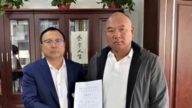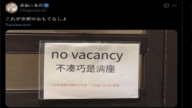【新唐人2014年04月19日訊】甘肅蘭州市日前爆發自來水「苯」超標事故後,大陸的水污染問題再度備受關注。據中共環保部最近發佈的一項調查結果,有2億8,000萬大陸居民使用不安全的飲用水。專家指出,在大陸,水污染無處不在,飲用「問題水」的人數,可能遠遠超過2.8億。
蘭州市自來水10號下午被檢測出「苯」嚴重超標,14號,蘭州市政府已宣佈恢復正常供水,但不少民眾仍對污染源以及「苯」快速大幅下降等原因,存有疑慮。
大陸《第一財經日報》指出,「飲用水源地安全」問題,引發民眾強烈關注。據中共環境保護部3月14號發佈的消息,全中國有2億8,000萬居民使用不安全飲用水,從水源地水質保護、取水、輸水、水處理、配水到終端用水,水質安全問題,在每一個環節都開始集中爆發。
「北京清華大學環境學院飲用水安全教研所」教授張曉健,他在接受媒體採訪時表示,「蘭州水污染」事故發生後,如果把原因披露、剖析,會發現事故不再是意外。蘭州的自來水污染絕不是個案,它反映了大陸城市供水普遍存在的問題。
蘭州這一次事故中,「威立雅水務集團」受污染的自流溝,被數家化工企業包圍。《中國青年報》報導說,一些業內專家認為,像蘭州這樣被重化工企業包圍的城市,躲不過飲用水安全危機。然而,在中國大陸,約有81%的化工、石化建設項目,布設在江河水域、人口密集區域。
報導引述「中國環境科學院環境安全基地」首席專家劉征濤的話說,飲用水的安全,與水源地、自來水廠的處理過程、以及管道輸送等三個環節相關,從現狀來看,水源地的安全風險最高。
浙江杭州環保維權人士陳法慶:「中國的飲用水的不安全因素很多,最主要的原因是環境污染造成的,現在中國的河流,百分之80左右都不同程度的存在著污染的問題,主要來源於一些化工企業。」
據了解,大陸有近70%的人口飲用地下水。據報導,「中國工程院」院士王浩等專家研究發現,由於工業廢水和生活污水的排放、農藥的使用、垃圾場的淋濾和地下油罐的滲漏等原因,地下水正遭受越來越嚴重的污染。
北京民間水專家張峻峰:「我們現在實際上只看到表面的、一個點狀的工業污染的情形,而且工業污染的體系容易出現這種極端事件,但在我們日常生活之中,農業的、農藥的污染,和我們生產生活的污水的污染,我們卻每天都見到,但每天我們都孰視無睹。因此,污染的水的狀態,按我的說法,應該是無處不無的。」
在管道輸送環節上,中共「住房和城鄉建設部」多年前曾調查數百個城市的供水管網,發現管網質量普遍低劣。
張峻峰:「大概50年代左右開始建設的,這些管道長年運行,在輸送的過程中,有一些維護的問題,還有其他各個方面的問題,促使水在管道裡流動的過程中,形成了一部分污染。另一因素是,現在的供水方式,基本上屬於二次供水,自來水廠加壓下來之後,流入居民樓的供水水箱,這個供水的儲水箱,長時間暴露於空氣中,它的安全可以說是最大最大的隱患。」
《第一財經日報》報導,近年來大陸城市供水水質問題不斷,各地接連發生的停水事件,讓居民擰開水龍頭時,便擔心流出來的會不會是「毒水」。這表示,喝不上安全飲用水的人數,可能遠遠超過2.8億。
張峻峰:「在北京的自來水裡面,我們依然會找到這種堆積的東西,或者這種污染的狀況,比如說他的各項指標,在出廠的時候,它的很多指標看上去是比較合格的,但是在居民的水龍頭流出來的,卻是和出廠的指標相差很大的。在北京這樣一個管理很嚴格的地方,都是這種狀態的話,更何況其他地區。」
「世界衛生組織」報告顯示,大陸每年因飲用被污染的水,而腹瀉死亡的人數達9萬5,600人。
採訪/朱智善 編輯/陳潔 後製/孫寧
Over 280 Million Chinese People Exposed to Unsafe Drinking Water
An outbreak of benzene-tainted drinking water in Lanzhou
has brought concern over drinking water safety in China.
The Chinese Communist Party (CCP) Ministry of
Environmental Protection reported that 280 million
Chinese are exposed to polluted drinking water.
Experts suggest that water pollution in China
has been so severe that there are many more
people are at risk than suggested by CCP statistics.
Seriously high levels benzene was detected in
the drinking water in Lanzhou City on April 10.
CCP authorities have claimed that
the problem has been resolved.
However, Chinese people are skeptical about the source
of contamination, and how it could be removed so quickly.
China Business News reported that the safety of
drinking water sources has been a concern for people.
On March 14, a Ministry of Environmental Protection
news release indicated that there are an estimated
280 million residents using unsafe drinking water in China.
Water pollution outbreaks are taking
place in the water supply chain.
This can take place at the water source, within the
transportation pipelines, at the treatment plants,
distribution systems, and at the faucets themselves.
Professor Zhang Xiaojian from the Division
of Drinking Water Safety, School of Environment,
Tsinghua University, spoke in an interview.
Professor Zhang said analysis of Lanzhou water pollution
suggests that this incident was not an isolated case.
In fact, it is a reflection of the common
water supply problems in urban China.
Take the latest tainted water incident as an example.
The water supplier, Lanzhou Veolia Water Company』s
culverts were surrounded by numerous chemical plants.
China Youth Daily reported that experts believe
a heavily industrialized city such as Lanzhou is
evidently at risk of drinking water contamination.
In China, about 81% of chemical and petrochemical
plants are located at water sources and in populated areas.
Chinese Research Academy of Environmental Sciences
researcher Liu Zhengtao spoke to mainland state media.
Among the three links of drinking water safety;
the source, the treatment at the plant and the
pipeline; the water source is the point at highest risk.
Chen Faqing, Hangzhou environmental activist: “There are
many factors in China that contribute to the drinking water
safety concerns. Environmental pollution is the main factor.
Around 80% of rivers in China are at varying degrees
of pollution, which is mainly from chemical plants.”
Nearly 70% of Chinese people drink groundwater.
According to research reports by the Chinese Academy
of Engineering, groundwater is at serious risk of pollutants.
This includes from industrial wastewater, domestic
sewage discharge, use of pesticides, leaching of
waste, and leakage from underground oil pipelines.
Zhang Junfeng, Beijing environmentalist: “They』re superficial
incidents of industrial pollution, which tend to be acute.
However, in our daily lives, we see pollution everywhere.
From agriculture, pesticides, and sewage, but we have
ignored them. I would say water pollution is everywhere.”
As for water pipelines, the CCP Ministry of Housing and
Urban-Rural Development has surveyed hundreds of cities.
It identified a wide distribution of unfit pipelines.
Zhang Junfeng: “They were built around the 1950s.
Years of running water have warranted maintenance
issues, and many other issues that caused pollution.
Nowadays, water is also supplied through a water tower
to residential buildings after treatment by a water plant.
The towers which have been exposed to
the air are just another big safety concern.”
China Business News said that tainted water
incidents have caused people to be constantly
worried about drinking water safety.
It is also considered that affected population
could be far greater than 280 million residents.
Zhang Junfeng: ”In Beijing tap water, we
still find deposits or incidents of pollution.
For instance, quality indicators could be quite normal at the
water plant, but the water from the residential tap is far off.
If this is the situation commonly seen in
Beijing, it is only worse in other areas of China.”
The World Health Organization has reported that
polluted drinking water has caused as many as
95,000 Chinese people to die of diarrhea every year.




























